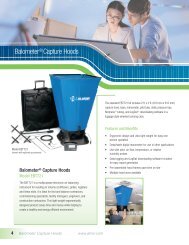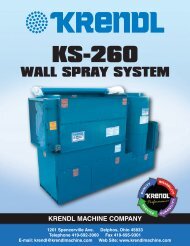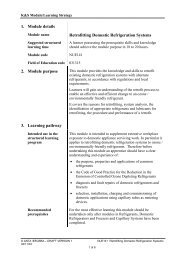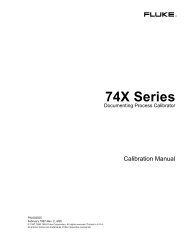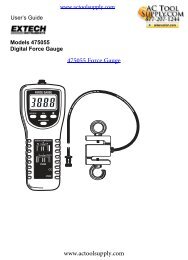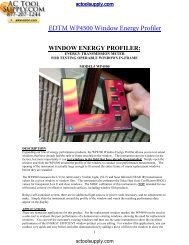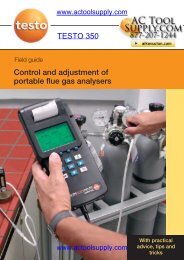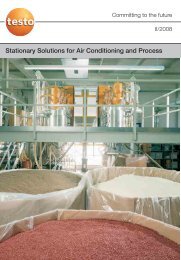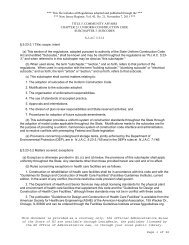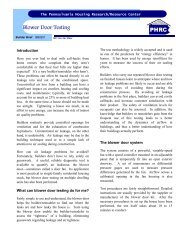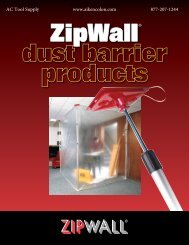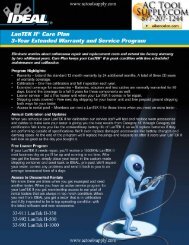MILLER DURAHOIST The - Honeywell Safety Products
MILLER DURAHOIST The - Honeywell Safety Products
MILLER DURAHOIST The - Honeywell Safety Products
Create successful ePaper yourself
Turn your PDF publications into a flip-book with our unique Google optimized e-Paper software.
USER INSTRUCTIONS - ENGLISH<br />
3.0 Operation and Use<br />
Geometric Requirements<br />
Select a level area near the work opening that will allow the mast to be leveled in accordance with the leveling<br />
bubble installed on the base. <strong>The</strong> location must also provide firm footing that will not allow the base to sink or<br />
shift while in use. Position the base so the mast will be directly over the work area. <strong>The</strong> winch/SRL cable must<br />
remain parallel to the mast while in use. Do not position the mast where the worker will have to swing under<br />
the mast to reach the work area. <strong>The</strong> acceptable working area is directly under the mast, between the stabilizer<br />
tubes. Avoid positioning the mast where the working line may abrade against sharp edges when in use.<br />
Requirements for Personal Fall Arrest Systems<br />
Personal fall arrest systems used with the mast and base typically include a full body harness, a connecting<br />
subsystem (self retracting lifeline or lifeline rope to grab), and the necessary hardware to connect the system.<br />
Personal fall arrest systems used with this mast and mounting base must meet applicable OSHA requirements.<br />
Personal fall arrest systems that use a full body harness must limit the fall arrest forces to 1800lbs, and arrest the<br />
fall within 42in. Body belts, unless part of a full body harness, are not recommended for use with this equipment.<br />
Inspection of Equipment Prior to Use<br />
•Check all structural parts for damage; dents, cracks,<br />
weld bends, or crushed tubes. Minor cosmetic<br />
damage will not affect the structural integrity of the<br />
system, but any seriously damaged parts must be<br />
repaired or replaced before use.<br />
•Check all hardware; pins, tri-screws, adjuster<br />
screws, nuts, bolts, pulleys, rollers, and winch<br />
brackets for damaged threads, bends, damaged<br />
or missing fasteners, or lose fasteners. Check all<br />
pulleys and rollers for chips, grooves, and excessive<br />
wear. Ensure that all pulleys and rollers turn freely.<br />
•Inspect all equipment for missing, damaged, or<br />
otherwise illegible warning stickers. Any damaged,<br />
missing, or otherwise illegible stickers must be<br />
replaced before using the system.<br />
Inspection & Maintenance of Harnesses<br />
Inspection/Maintenance Schedule<br />
•Daily (before each use):<br />
See above “Inspection of Equipment Prior to Use”.<br />
•If you are using Miller DuraHoist winches with your<br />
system, inspect the winch and cable as outlined in<br />
their respective operator’s manual.<br />
•Any additional winches, self retracting lifelines<br />
(SRL’s), work positioning, or fall-arrest equipment<br />
being used with your Miller DuraHoist System must<br />
be installed, inspected, maintained, and operated<br />
according to manufacturer’s instructions.<br />
•Report any problems with the equipment to your<br />
supervisor and do not use the equipment until it has<br />
been repaired or replaced.<br />
•Store this equipment in a clean and dry environment<br />
out of direct sunlight. Avoid areas with chemical<br />
vapors. Inspect equipment after any period of<br />
extended storage.<br />
Miller harnesses are designed for today’s rugged work environments. To maintain their service life and high<br />
performance, harnesses should be inspected frequently. Inspect the harness thoroughly before each use. Regular<br />
inspection by a competent person for wear, damage or corrosion should be a part of your safety program. Inspect<br />
your equipment daily and replace it if any defective conditions are found.<br />
•Weekly:<br />
Perform a complete visual inspection of equipment as outlined in “Inspection of Equipment Prior to Use“. Clean<br />
equipment as required to thoroughly inspect all welds, labels, pins, fasteners, pulleys, rollers, brackets, and parts.<br />
If any problems are found with the equipment do not use until it has been repaired.<br />
•Biannually:<br />
To be completed at least twice a year (every six months). Clean unit thoroughly using a damp cloth and a mild<br />
soap solution. Perform a complete visual inspection as described above in “Inspection of Equipment Prior to Use”.<br />
Record date of inspection on inspection sticker. If any problems are found with the equipment, do not use until it<br />
has been repaired.



